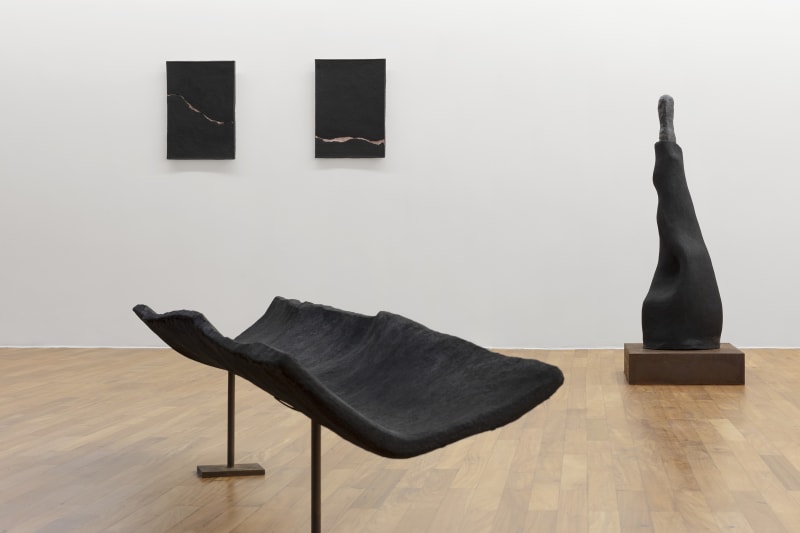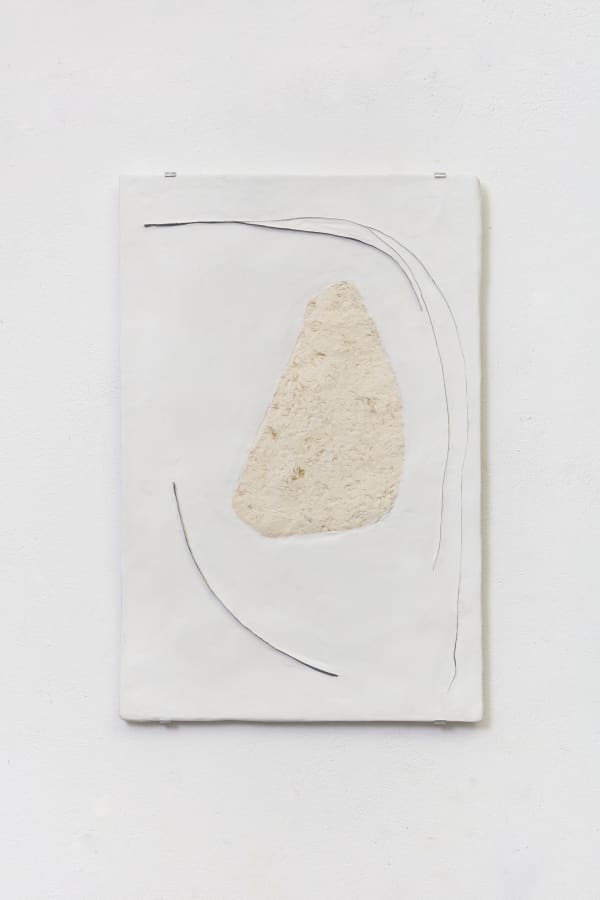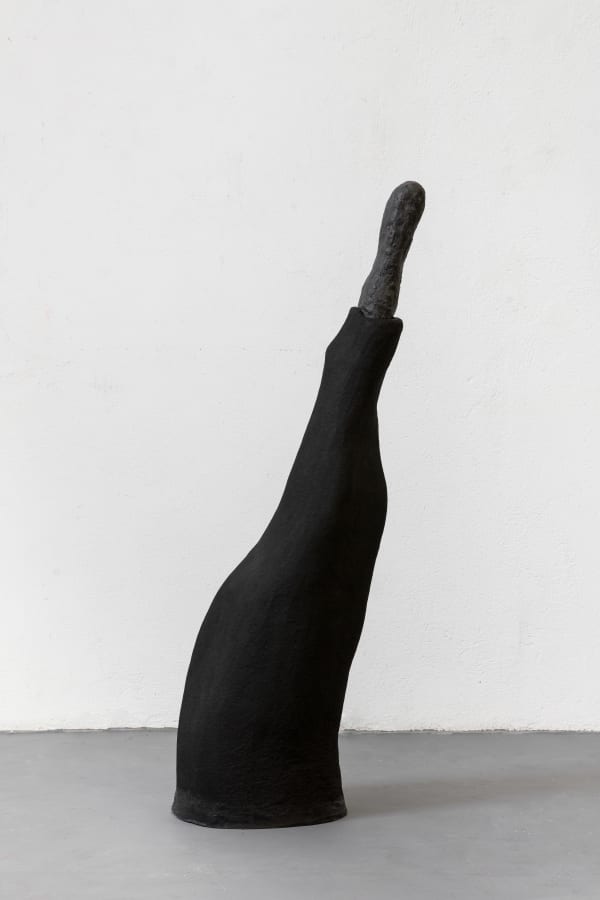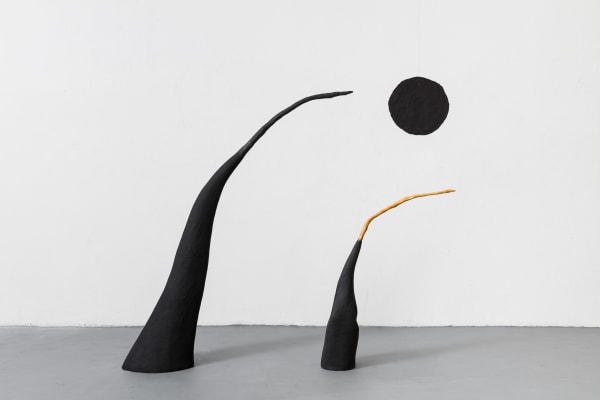noite não noite sim Paloma Bosquê
O Night, faithful preserver of mysteries
Ovid — Metamorphoses, Book VII, 1920
noite não noite sim [one other night], Paloma Bosquê’s third solo show at Mendes Wood DM São Paulo, presents a series of sculptural objects that, by placing in tension the distinction between the animate and the inanimate, reveal the strengthening of the artist’s relationship with the signs and matter that constitute what we understand as the inhuman universe. Matter, after all, never shirks.
The works seem to be constantly imbued with metamorphosis, not only in terms of the process that the substances composing each piece go through, but also, and above all, their transformational character. In one of Bosquê’s Placas [Plates], made of cotton fiber and dental stone, we can see, rather than a riverbed, the slow and winding course of lava running down from a volcano. In another, a round figure occupies a grayish space bordered by the darkness that covers the other half of the painting. Here, we have not only the notion of threshold, frontier, but also a recurring egg-like shape. The Portuguese word “gema” [meaning both gem and yolk] refers not only to the stones but also to resin, to budding and to the core of an egg, therefore, we witness both the resistance of matter and its creational potentiality.
This transformational aspect is also manifest in the animism that infuses the objects. In Cobra de duas cabeças [Tow Headed-Snake], cotton fiber and banana tree trunk fiber, both vegetal elements, converge into an animal-shaped two-pronged form. In Sargaços [Sargassum], two gut-looking structures made of wool suggest the suspended claws of an undefined animal. Thus, there is nothing stable in what we perceived as idle.
Pointing to liminal territories, questioning that which we consider intrinsically human, vegetal or animal, the sculptures of noite não noite sim arise from a gesture of reciprocity between the several elements of our terrestrial landscape. In a sort of physical struggle with these elements, and in the counterflow of domination or appropriation of matter, Bosquê works with a gesture of mutual and transversal mobilization. Matter animates the hand and the hand animates matter, which rises up, insisting and challenging the hand with its enigma. What emanates from the encounter between the body of the artist and the body of things? How long does the incision of hand over matter last? At what point does the repetition of this incision gain status of memory?
In noite não noite sim, the work that lends title to the exhibition, two pointed silhouettes reach out to a black sun, summarizing the ambivalence of the movement towards the permeable limits of organisms, and towards bewilderment. Beaks or sharp claws threaten us, evoking a reverse flash: the fertile night of the woods, where beings and things coexist and remain despite us.
— Julia de Souza
-
 Paloma Bosquê, Plate / Placa, 2020
Paloma Bosquê, Plate / Placa, 2020 -
 Paloma Bosquê, Plate / Placa, 2020
Paloma Bosquê, Plate / Placa, 2020 -
 Paloma Bosquê, Plates / Placas, 2020
Paloma Bosquê, Plates / Placas, 2020 -
 Paloma Bosquê, Plate / Placa, 2020
Paloma Bosquê, Plate / Placa, 2020 -
 Paloma Bosquê, Plate / Placa, 2020
Paloma Bosquê, Plate / Placa, 2020 -
 Paloma Bosquê, Plate / Placa, 2020
Paloma Bosquê, Plate / Placa, 2020 -
 Paloma Bosquê, Plate / Placa, 2020
Paloma Bosquê, Plate / Placa, 2020 -
![Paloma Bosquê, Placa [Plate], 2020](data:image/gif;base64,R0lGODlhAQABAIAAAAAAAP///yH5BAEAAAAALAAAAAABAAEAAAIBRAA7) Paloma Bosquê, Placa [Plate], 2020
Paloma Bosquê, Placa [Plate], 2020 -
 Paloma Bosquê, Plate | Placa, 2020
Paloma Bosquê, Plate | Placa, 2020 -
 Paloma Bosquê, Plate / Placa, 2020
Paloma Bosquê, Plate / Placa, 2020 -
 Paloma Bosquê, Plate | Placa, 2020
Paloma Bosquê, Plate | Placa, 2020 -
 Paloma Bosquê, Plate / Placa, 2020
Paloma Bosquê, Plate / Placa, 2020 -
 Paloma Bosquê, Plate / Placa, 2020
Paloma Bosquê, Plate / Placa, 2020 -
 Paloma Bosquê, Plate | Placa, 2020
Paloma Bosquê, Plate | Placa, 2020 -
 Paloma Bosquê, Dowel (termite mound) / Pino (cupinzeiro), 2020
Paloma Bosquê, Dowel (termite mound) / Pino (cupinzeiro), 2020 -
 Paloma Bosquê, Two Headed Snake | Cobra de Duas Cabeças, 2020
Paloma Bosquê, Two Headed Snake | Cobra de Duas Cabeças, 2020 -
 Paloma Bosquê, Snake / Cobra, 2020
Paloma Bosquê, Snake / Cobra, 2020 -
 Paloma Bosquê, Gutter | Calha, 2020
Paloma Bosquê, Gutter | Calha, 2020 -
 Paloma Bosquê, One Other Night | Noite Não, Noite Sim, 2020
Paloma Bosquê, One Other Night | Noite Não, Noite Sim, 2020 -
 Paloma Bosquê, Sargaço | Seaweed, 2020
Paloma Bosquê, Sargaço | Seaweed, 2020








![Paloma Bosquê, Placa [Plate], 2020](https://artlogic-res.cloudinary.com/w_600,c_limit,f_auto,fl_lossy,q_auto,dpr_auto/artlogicstorage/mendeswooddm/images/view/41157489659249c544597efe77c2979dj/mendeswooddm-paloma-bosqu-placa-plate-2020.jpg)













